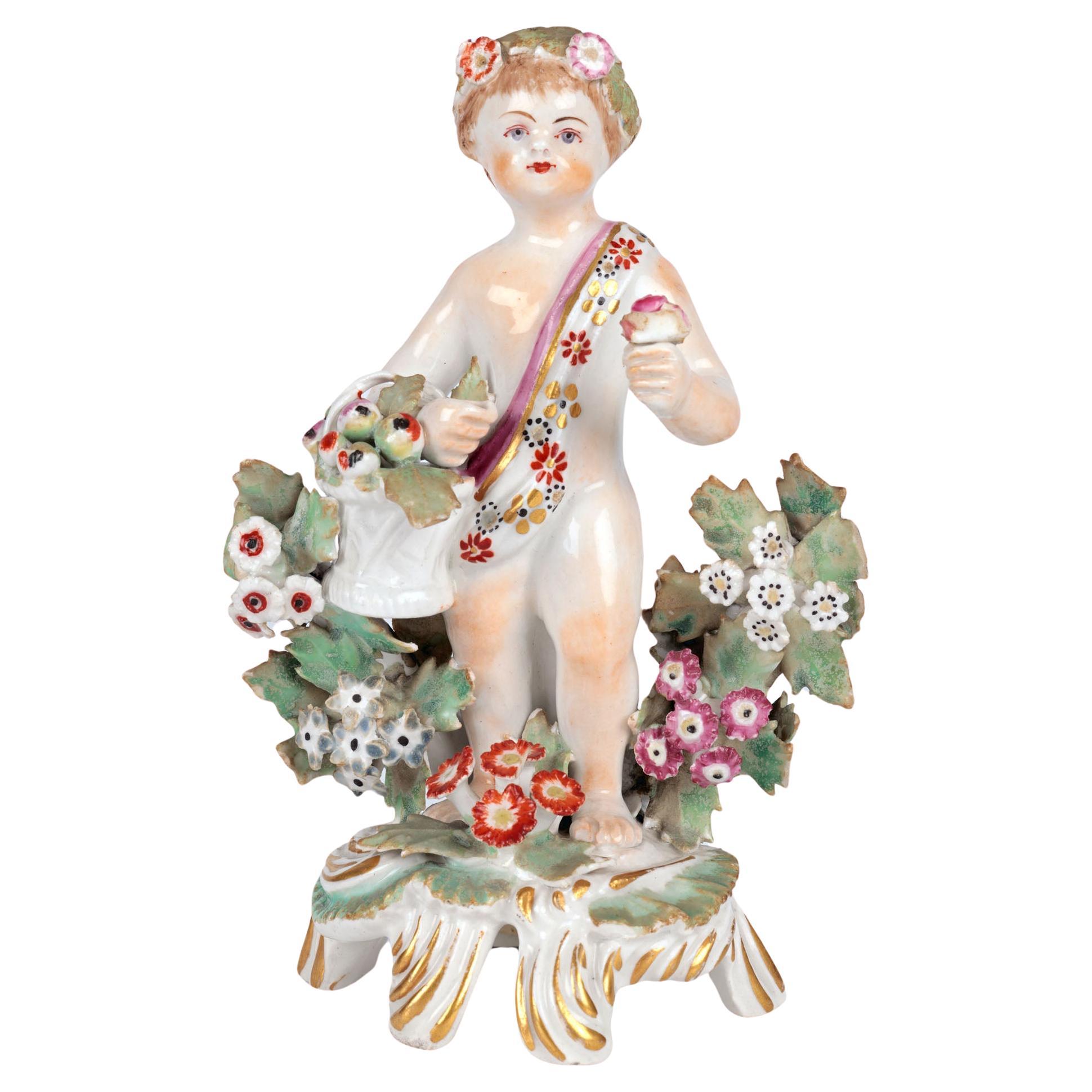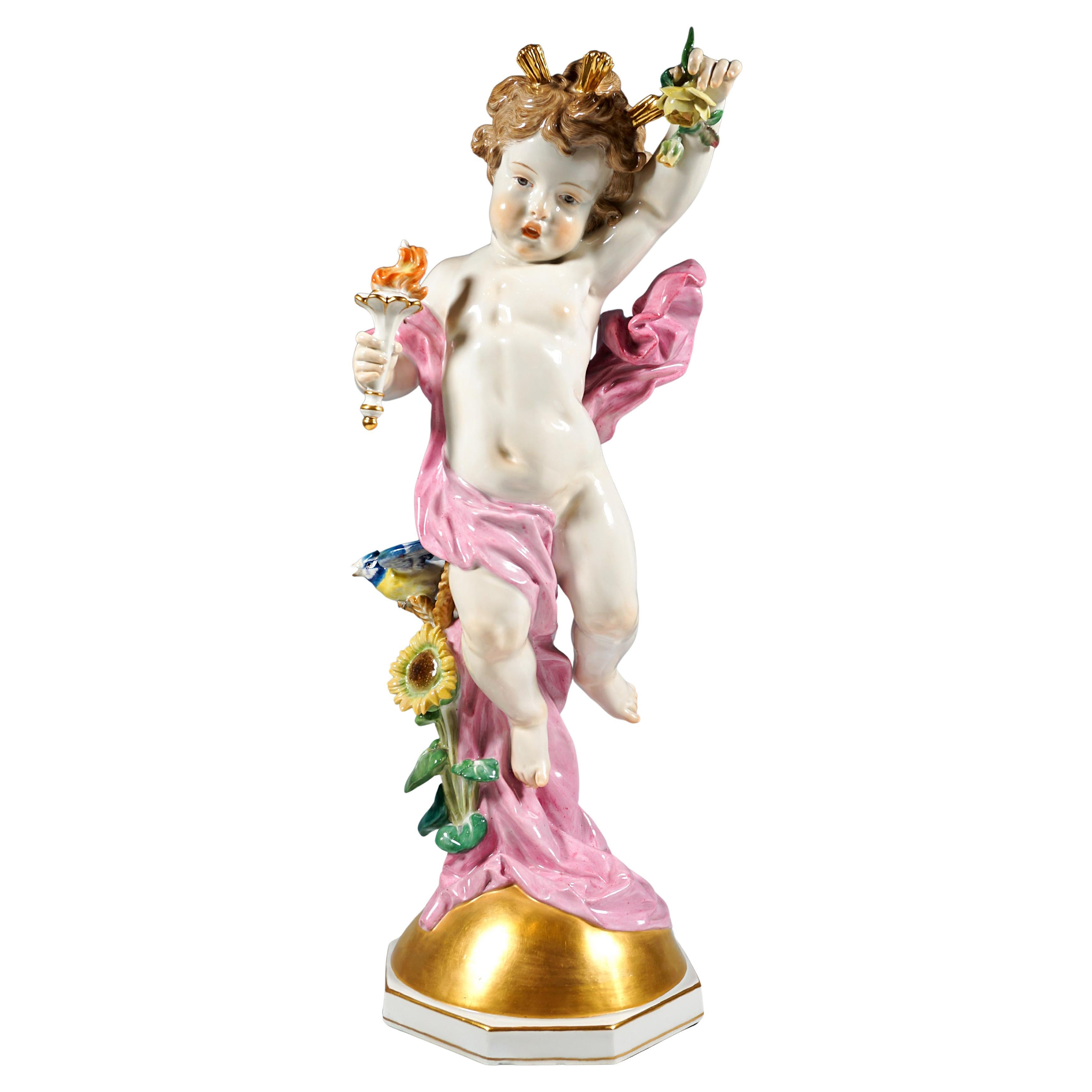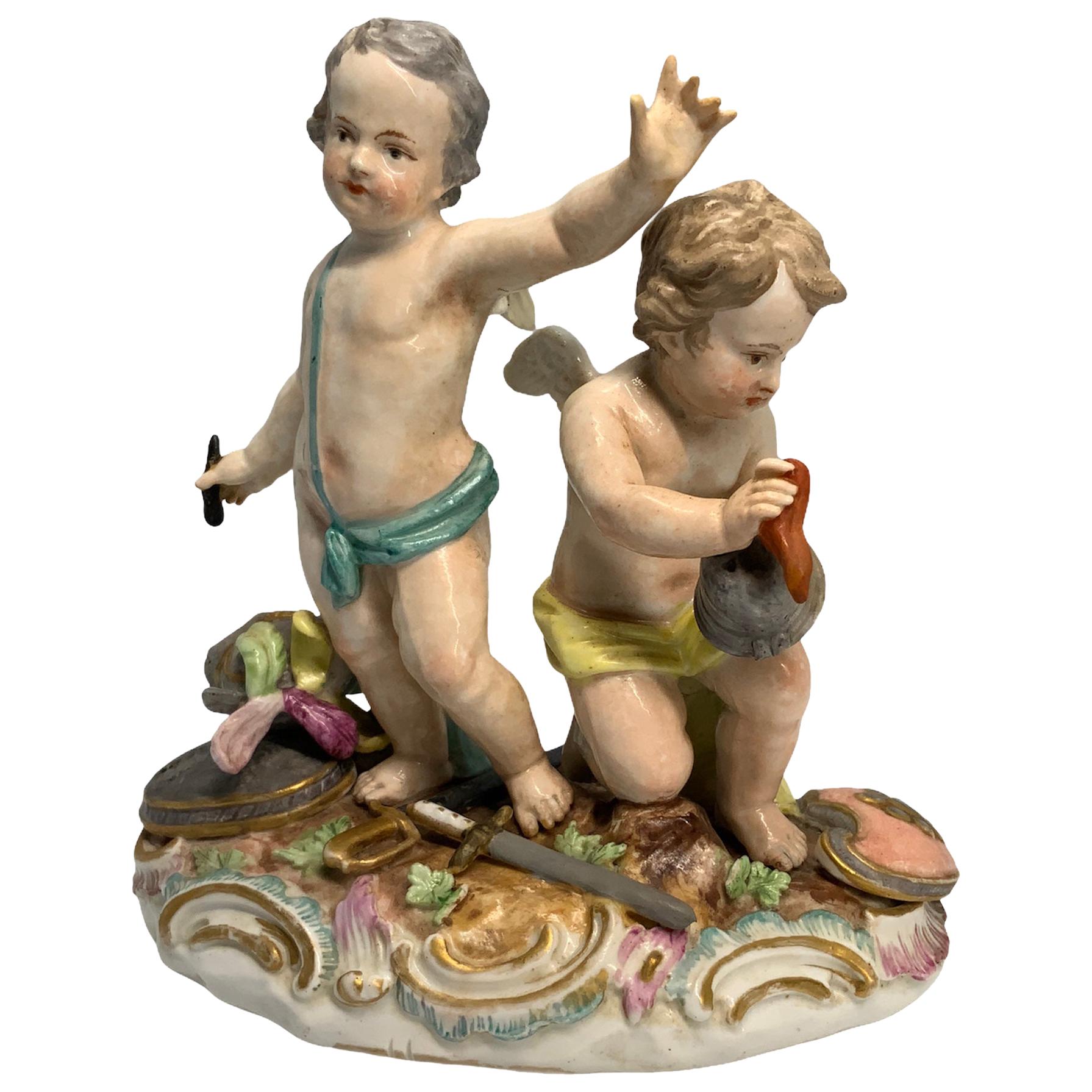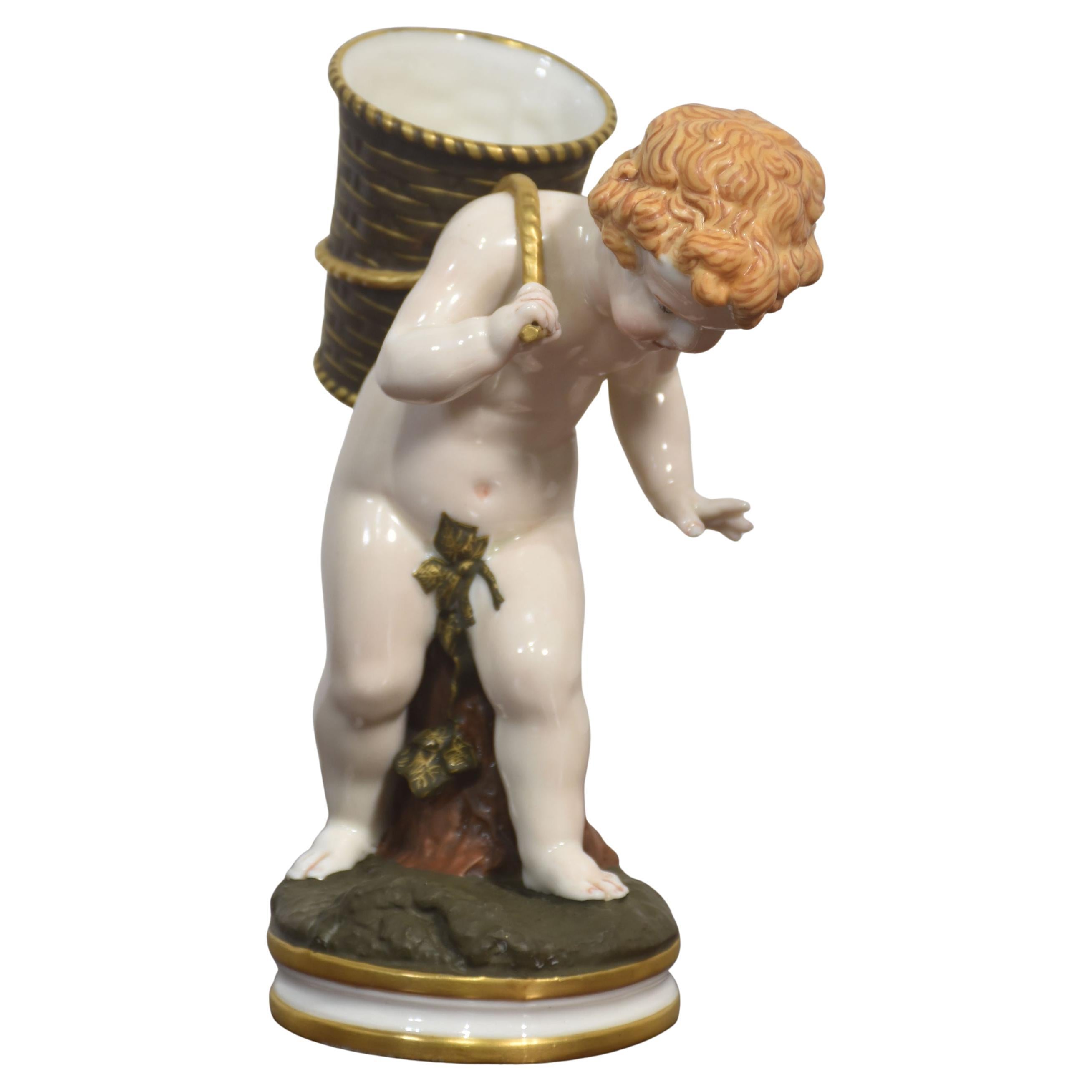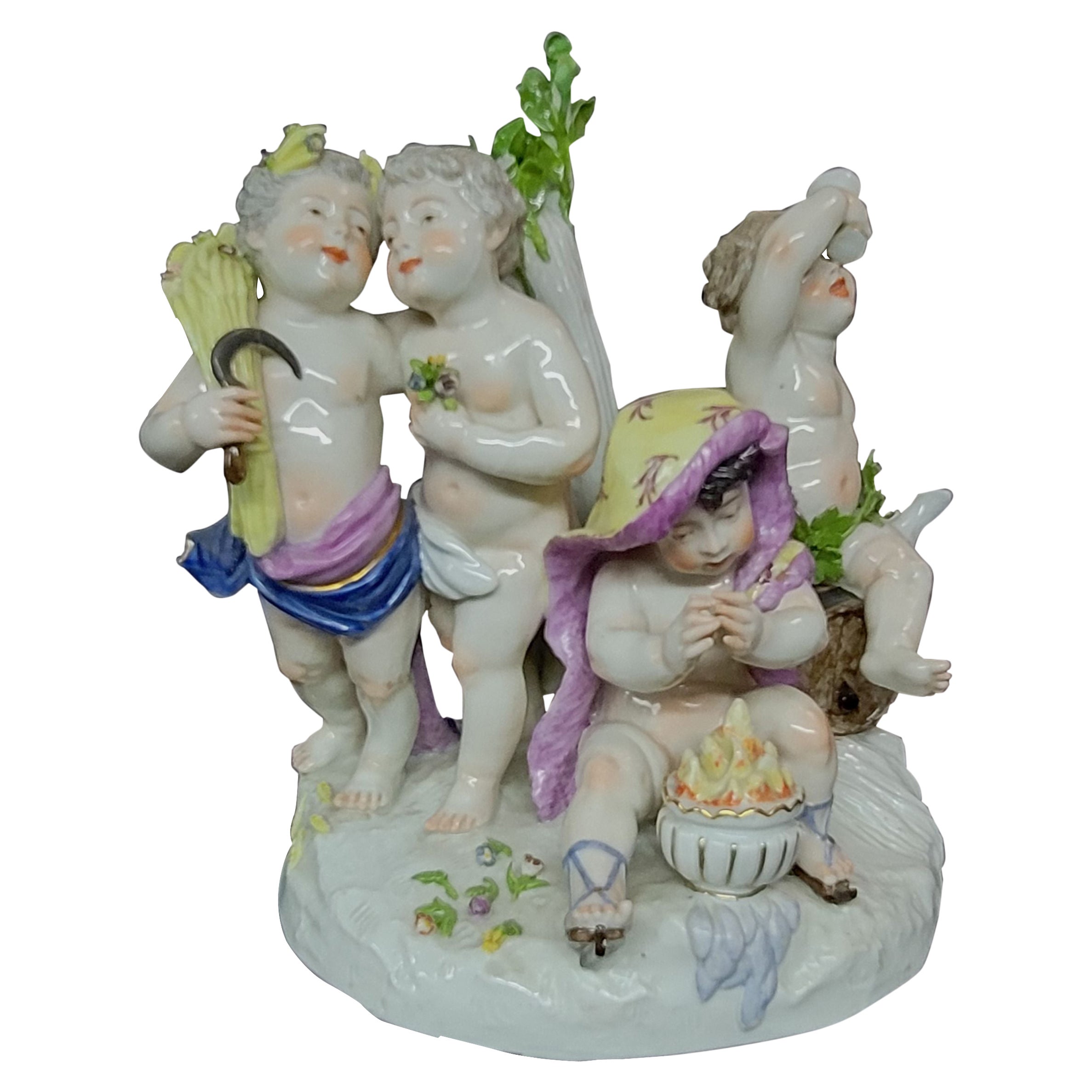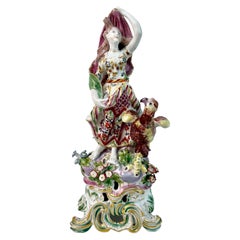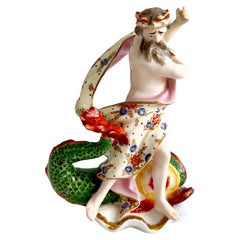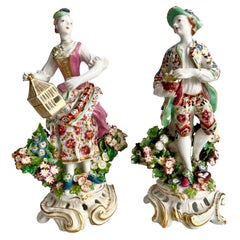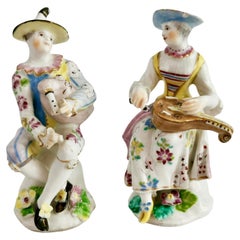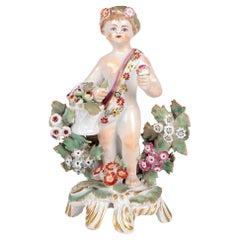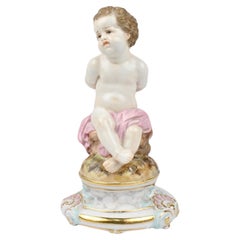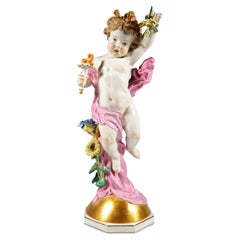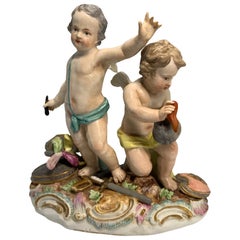Items Similar to Bow Porcelain Figure of Boy Putto on C-Scroll Base, Georgian circa 1760
Want more images or videos?
Request additional images or videos from the seller
1 of 16
Bow Porcelain Figure of Boy Putto on C-Scroll Base, Georgian circa 1760
$685
£522.17
€596.54
CA$963.89
A$1,055.76
CHF 555.86
MX$12,600.15
NOK 7,083.91
SEK 6,475.76
DKK 4,457.78
About the Item
This is a wonderful little figure of a boy or putto made by the Bow Porcelain factory in about 1760.
The Bow Porcelain Factory was one of the first potteries in Britain to make soft paste porcelain, and most probably the very first to use bone ash, which later got perfected by Josiah Spode to what is now the universally used "bone china". Bow was the main competitor of the Chelsea Porcelain Factory, but where Chelsea made very fine slipcast porcelain, Bow made a different soft paste porcelain that tended to be softer and could be pressed into moulds. Bow served a larger public generally at lower prices. The factory was only in operation between 1743 and 1774, after which the tradition got incorporated into some of the later famous potteries such as Worcester and Derby.
This boy or putto figure was first modelled in the 1750s, which was at the height of Bow's ability to make beautiful figurines often copied from Chelsea or Meissen. This particular one is from a little later (1760), when Bow started putting their figures on top of a Rococo C-scroll base. This putto may originally have had a bocage, or flower tree, behind him. The putto is seated on a beautiful puce-tinted Rococo C-scroll that is typical for the Bow figures of 1760 onwards. The way we know this is a boy is the placement of the ribbon over his left shoulder; with girl figures, Bow placed the ribbons on the right shoulder.
These figures were used to adorn the dinner table when dessert was served; groups of figures served to express something about the host, the guests, or to direct the conversation. Putti were symbolic for God's omnipresence, as well as the sacred dimension of worldy pleasures. They were very popular in the 18th Century. This figure would make a fabulous gift to a loved one, and with its high artistic value it is a wonderful little piece of decoration for any interior design style.
The item is unmarked, which is common for Bow items of this era.
CONDITION REPORT The figure is in good condition although it has some professional repairs, which is common for these figures. The left arm and both legs show some signs of repair, and the face and the body have had some touch-ups. One of the legs of the base is repaired and touched up. There might have been a now missing bocage at the back of the head of the putto. There are some typical missing flower petals on the remaining bocage. However, overall the figure looks brilliant and is in good stable condition.
Antique British porcelain is never perfect. Kilns were fired on coal in the 1700s, and this meant that china from that period can have some firing specks from flying particles. British makers were also known for their experimentation, and sometimes this resulted in technically imperfect results. Due to the shrinkage in the kiln, items can have small firing lines or develop crazing over time, which should not be seen as damage but as an imperfection of the maker's recipes, probably unknown at the time of making. Items have often been used for many years and can have normal signs of wear, and gilt can have signs of slight disintegration even if never handled. I will reflect any damage, repairs, obvious stress marks, crazing or heavy wear in the item description but some minor scratches, nicks, stains and gilt disintegration can be normal for vintage items and need to be taken into account.
There is widespread confusion on the internet about the difference between chips and nicks, or hairlines and cracks. I will reflect any damage as truthfully as I can, i.e. a nick is a tiny bit of damage smaller than 1mm and a chip is something you can easily see with the eye; a glazing line is a break in the glazing only; hairline is extremely tight and/or superficial and not picked up by the finger; and a crack is obvious both to the eye and the finger. Etcetera - I try to be as accurate as I can and please feel free to ask questions or request more detailed pictures!
DIMENSIONS height 12cm (4.75").
- Creator:Bow Porcelain (Maker)
- Dimensions:Height: 4.75 in (12.07 cm)Width: 2.5 in (6.35 cm)Depth: 2.5 in (6.35 cm)
- Style:Rococo (Of the Period)
- Materials and Techniques:
- Place of Origin:
- Period:1760-1769
- Date of Manufacture:circa 1760
- Condition:Repaired: professional repairs to left arm and leg, and some touching up of face and body; front right scroll professionally repaired. Still looking bright. Wear consistent with age and use. Minor losses. Some minor losses to flower petals, some light repairs, as visible in the pictures, see description.
- Seller Location:London, GB
- Reference Number:Seller: A-BOW021stDibs: LU4805115285911
About the Seller
5.0
Vetted Professional Seller
Every seller passes strict standards for authenticity and reliability
Established in 2016
1stDibs seller since 2019
228 sales on 1stDibs
- ShippingRetrieving quote...Shipping from: London, United Kingdom
- Return Policy
More From This Seller
View AllBow Porcelain Figure of Juno with Eagle 'Jupiter', Rococo Ca 1765
By Bow Porcelain
Located in London, GB
This is a very rare and impressive large figure of Juno with an eagle, made by the Bow Porcelain factory in about 1765. This figure formed part of a series of the Four Elements, with...
Category
Antique 1760s English Rococo Figurative Sculptures
Materials
Porcelain
Derby Porcelain Figure of Neptune and Dolphin on a Shell, ca 1785
By Derby
Located in London, GB
This is a stunning porcelain figure of Neptune with a dolphin standing on a sea shell, made by Derby around the year 1785. The figure is in beautiful original condition.
We have one other Neptune figure from 1765, please see separate listing.
The Derby Porcelain factory has its roots in the late 1740s, when Andrew Planché, a Walloon Huguenot refugee, started making simple porcelain toys shaped like animals in his back yard. In 1756 Staffordshire enameller...
Category
Antique 1780s English Rococo Figurative Sculptures
Materials
Porcelain
Bow Pair of Porcelain Figures of Liberty & Matrimony, Rococo 1760-1764
By Bow Porcelain
Located in London, GB
This is a fabulous pair of figures of Liberty and Matrimony made by the Bow Porcelain factory between 1760 and 1764. These figures were a popular pair portraying marriage.
The bow p...
Category
Antique 1760s English Rococo Figurative Sculptures
Materials
Porcelain
Bow Pair of Porcelain Figures, Arlecchino and Columbina, Rococo ca 1758
By Bow Porcelain
Located in London, GB
This is a wonderful pair of figures of Arlecchino and Columbina, made by the Bow Porcelain factory in about 1758. These figures formed part of a series of the Commedia dell'Arte, a very popular series of theatrical figures that served as decoration at the dinner table in the 18th Century.
The Bow Porcelain Factory was one of the first potteries in Britain to make soft paste porcelain, and most probably the very first to use bone ash, which later got perfected by Josiah Spode to what is now the universally used "bone china". Bow was the main competitor of the Chelsea Porcelain Factory, but where Chelsea made very fine slipcast porcelain, Bow made a different soft paste porcelain that tended to be softer and could be pressed into moulds. Bow served a larger public generally at lower prices. The factory was only in operation between 1743 and 1774, after which the tradition got incorporated into some of the later famous potteries such as Worcester and Derby.
These figures were used to adorn the dinner table when dessert was served; groups of figures served to express something about the host, the guests, or to direct the conversation. The Italian Commedia Dell'Arte, a comical form of masked theatre, was very popular in those days and Bow copied many figures of the German Meissen series that were brought out in the decades before.
This pair dates from about 1758, which was at the height of Bow's ability to make beautiful figurines often copied from Chelsea or Meissen. The pair is modelled after a Meissen pair by Kaendler. The porcelain is translucent with a beautiful milky glaze - Bow was probably the first pottery using bone in its porcelain recipe. Arlecchino (Harlequin) is playing the bagpipes, dressed in an odd costume of mismatched chintz and playing cards and wearing a funny black trumpet...
Category
Antique 1750s English Rococo Figurative Sculptures
Materials
Porcelain
Derby Figure of Shepherdess with Garlanded Lamb, ca 1760
By Derby
Located in London, GB
This is a charming Derby figure of a shepherdess with a garlanded lamb, made in or shortly after 1760. The figure is one half of a set called the "Garland...
Category
Antique 1760s English Rococo Figurative Sculptures
Materials
Porcelain
Bloor Derby Pair of Porcelain Figures, Stag and Doe, circa 1765-1820
By Bloor Derby, Derby
Located in London, GB
This is a very charming pair of porcelain figures of a stag and a doe, probably cast by Derby in about 1760 and decorated by Bloor Derby in 1820. The figures are a simple white porce...
Category
Antique 1760s English Rococo Figurative Sculptures
Materials
Porcelain
You May Also Like
Bow English Porcelain Putto Figure With Flowers
Located in Bishop's Stortford, Hertfordshire
A scarce antique English porcelain figure of a Putto holding a basket of flowers by the renowned Staffordshire factory Bow and dating from aro...
Category
Antique 1760s English Figurative Sculptures
Materials
Porcelain
Old or Antique Meissen Porcelain Figurine of Cupid with Bound Wings
By Meissen Porcelain, Heinrich Schwabe 1
Located in Philadelphia, PA
A fine old or antique Meissen porcelain figurine.
Depicting Cupid sitting atop a rock with a sad expression, both hands and wings bound behind his back.
Atop a circular gilt Rococo...
Category
Antique Late 19th Century German Rococo Revival Figurative Sculptures
Materials
Porcelain
Large Meissen Porcelain Figure, Putto 'The Day', by Heinrich Schwabe, Mid-20th
By Heinrich Schwabe 1
Located in Vienna, AT
Large putto floating above the earth's atmosphere:
Day, in a bright pink robe, holding a rose blossom in his left arm, stretching upwards full of morning energy, in his right hand a ...
Category
Mid-20th Century German Rococo Porcelain
Materials
Porcelain
Royal Porcelain or State’s Porcelain Manufactory 'KPM' Cherub’s Sculpture
By KPM Porcelain
Located in Guaynabo, PR
This rare porcelain group sculpture depicts a pair of winged warriors cherub figurines. They are without their helmet, armor, and swords. One is in a victorious posture and the other...
Category
Antique 19th Century German Rococo Figurative Sculptures
Materials
Porcelain
$600 Sale Price
20% Off
Royal Worcester Porcelain Figure – Cherub with Basket
Located in Cheshire, GB
A beautifully crafted Royal Worcester porcelain figurine depicting a cherub carrying a large basket on its back. The figure is rendered with exquisite attention to detail, showcasing...
Category
Early 20th Century British Figurative Sculptures
Materials
Porcelain
Antique Ludwigsburg Porcelain "Putti" Group, 19th Century
Located in Norton, MA
A 19th cent porcelain group by Ludwigsburg depicts a group of frolicking putti angels, completed with hand-painted accents and a glossy glaze. Stamped along the underside with Ludwig...
Category
Antique 19th Century German Figurative Sculptures
Materials
Porcelain
More Ways To Browse
Antique Bow Ribbon
Rococo Scroll
Antique Soft Paste
Rococo Porcelain Sculptures
Soft Paste Antique Porcelain
Porcelain Boy
Putto Sculpture
Antique Chelsea Porcelain
Late Spode
Hand Painted Chinese Porcelain Figurines
Bow Porcelain Figure
Bow China
Derby Figure
Bow Figurine
Art Deco Figures
Large Statues
Antique Grand Tour Bronze Sculpture
Antique Replicas
